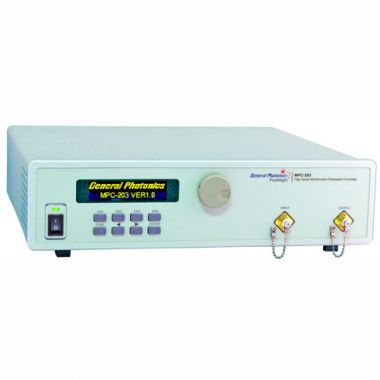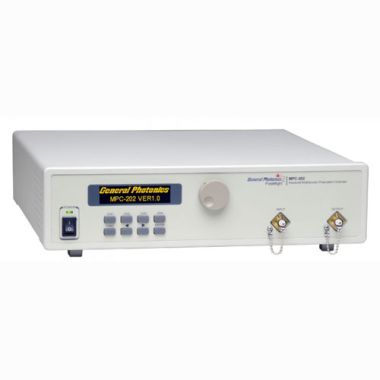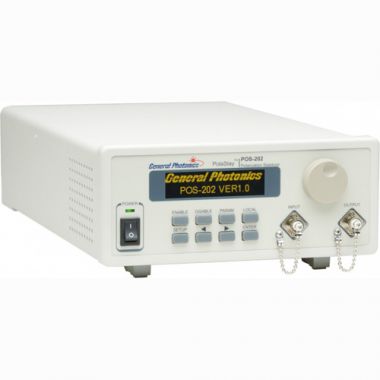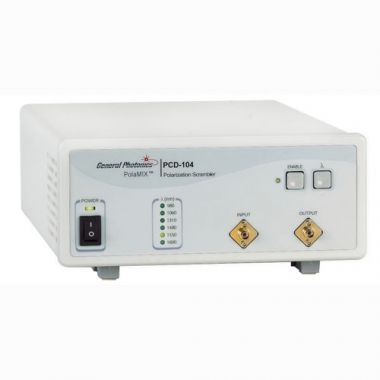LUNA PSY-201 – Polarisation Synthesizer/Analyser
- Up to 4M samples/s
- 1 MHz analog bandwidth
- 45 dB input power dynamic range
- Real-time Poincaré Sphere display
- High-speed SOP generation and tracking
- High speed analog output of SOP & DOP
- Data logging of SOPs changes up to 1 billion point
The LUNA PSY-201 generates and maintains any state of polarisation (SOP), regardless of the input SOP. It combines LUNA’s patented controller, polarimeter, and control algorithms into an instrument that functions as both an SOP generator and a polarisation analyser.
The generated SOP and the corresponding Poincaré representation are displayed on a PC via USB interface. Output SOP can be defined by Stokes parameters, by manually tuning the SOP to any point on the Poincaré sphere or by optimising a polarisation-dependent metric. Once a desired output SOP is found, the instrument maintains the SOP against input SOP fluctuations.
The user can generate 6 distinct SOPs (0°, 90°, ± 45°, RHC and LHC) for Mueller matrix calculations, or select any of the 6 states at the touch of a button.
The PSY-201 contains programmed SOP traces of common polarisation variations. It can also function as a polarisation scrambler, generating SOP scans with user-defined parameters and, with the internal polarisation controller disabled, it can function as an in-line polarimeter, displaying the instantaneous SOP and DOP of the input light beam.
The PSY-201 also features data logging function for long term measurement of polarisation changes of up to 1 billions points.
APPLICATIONS
- Polarisation Sensitivity Analysis of Receivers
- Monitoring of SOP
- Polarisation Generation and Stabilisation
- Sensor System Characterisation
- 100G System Characterisation
PSY-201 APPLICATION EXAMPLE
Sample setup for a coherent receiver performance test using a polarisation stabiliser (POS-202) and a polarisation synthesizer (PSY-201).
- Use polarisation stabiliser (POS-202) to lock the polarisation of one receiver input (local oscillator input).
- Use polarisation synthesizer (PSY-201) to control the polarisation of the other receiver input to find the SOP that maximises the receiver power reading.
- Lock the PSY-201 output at that SOP to eliminate polarisation fluctuations in the SM fibre. Test receiver performance.
- Use PSY-201 to find or switch to the orthogonal SOP (minimise receiver power reading).
- Lock PSY-201 output at that SOP to eliminate polarisation fluctuations. Test receiver performance.
|
Operating Wavelength Range |
1480 to 1620 nm or 1280 to 1340 nm |
|
Sampling Rate (max.) |
4.0M SOP samples/s |
|
Analog Bandwidth1 |
1MHz |
|
SOP Settling Time |
1ms at stable input SOP |
|
SOP Stability (Input Power > -25 dBm, DOP > 95%) |
0.1° with stable input SOP 0.5° with input SOP variation < 2 π/s 2° with input SOP variation < 10 π/s |
|
SOP Measurement/Generation Uncertainty |
±0.25° after user calibration, with input > -25 dBm |
|
DOP Uncertainty |
±2% using built-in calibration, with input > -25 dBm ±0.5% after user calibration, with input > -25 dBm |
|
Input Stokes Parameter Resolution |
0.001 |
|
Optical Power Uncertainty |
±0.25 dB |
|
Insertion Loss |
1.6 dB max. at center wavelength |
|
Return Loss |
55 dB (APC connector), 45 dB (PC connector) |
|
PDL |
< 0.25 dB |
|
PMD |
< 0.1 ps |
|
Operating Power Range |
-35 dBm to +10 dBm |
|
Optical Power Damage Threshold |
300 mW |
|
Operating Temperature |
0 °C to 40 °C |
|
Storage Temperature |
-20 °C to 60 °C |
|
Front Panel Display |
Graphic OLED |
|
Communication Interfaces |
High Speed USB 2.0 (30 MB/s data rate) for PolaViewsoftware, RS-232, Ethernet, GPIB |
|
Analog Output |
0 to 5 V max range, user configurable Monitor voltage for DOP, S1, S2, S3, power or dREF |
|
Power Supply |
100 – 240 VAC, 50 – 60 Hz |
|
Software |
PolaView™ (included) |
|
Dimensions |
2U, 19” half rack width 14" (L) x 8.5" (W) x 3.5" (H) |
|
Notes: Loss specifications are referenced without connectors. Unless otherwise noted, specifications listed in table apply for standard 1480-1620nm or 1280-1340nm operation at 23±5°C, at power levels >-25 dBm. 1 For input power > -10 dBm. At lower power levels, bandwidth may change due to automatic gain control.
|
|















